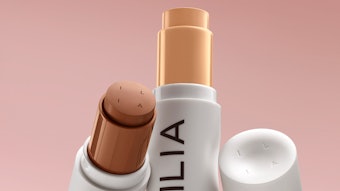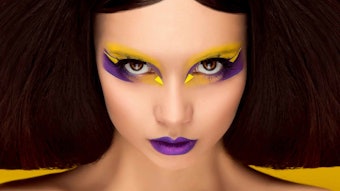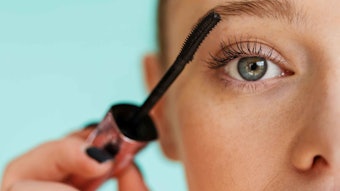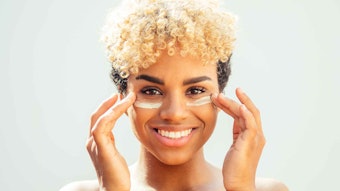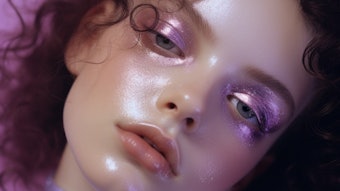For many women, the most favorable facial profile is V-shaped or a slim oval; narrowing from the cheeks down to the chin to resemble a “V.” This shape is interpreted to be more attractive, feminine and younger. Aesthetic and invasive treatments to achieve this look have become increasingly popular.1, 2 There are also non-surgical options to achieve this effect such as the use of onabotulinumtoxinAa,3-5 face rollers, heat masks and other topical skin care products for slimming and firming the face. These non-surgical treatments gradually change the face, resulting in a thinner look. Another option, explored here, is to provide a slimmer appearance without physical change—i.e., the use of makeup to create the illusion of a thinner, V-line face. Described here is a facial powder formulated with layered color-travel pigments to provide such an effect, and evaluations to determine its efficacy.
Optical Effects
Studies have shown that color-travel pigments provide angle-dependent optical effects6, 7 that can be beneficial for cosmetics, such as to contour the face. For the present study, a facial powder was formulated with layered color-travel pigments composed of mica coated with titanium dioxide, iron oxides and silica. These multi-layered pigments reflect light at specular and diffusion angles to impart a color-flop effect of brightness and darkness, respectively. Figure 1 shows a schematic of the pigments with these light reflection effects.
In relation, facial powder is one of the most fundamental and commonly used makeup products. It is easy to use and its effects to improve appearance are instant, immediately covering one’s complexion and imperfections, absorbing grease and oil, and giving a smooth, matte finish to the face. Facial powder was therefore chosen as the best vehicle to employ the described color-travel pigments. Following are assessments of the pigments themselves and the facial powder containing them, to determine their ability to highlight and shade some facial areas, and impart a more V-shaped look.
Materials and Methods
Pigments: Before developing a facial powder, the test and reference pigments were characterized to determine their particle sizes, which influence light-scattering. Both white pearlescent, single-coating layer pigmentsb and multi-layered color-travel pigmentsc were measured for mean particle size and size distribution using laser diffractiond. The mean particle size was expressed as a volume diameter of 50% [d (0.5)], whereas the size distribution was described by the SPAN statistical parameter. These pigments were also morphologically observed using a scanning electron microscope (SEM)e.
Preparation of pigments: Separately, the white pearlescent pigments and color-travel pigments were each added at 3% in a film base solution composed of 10% nitrocellulose in a mixture of organic solvents, ethyl acetate, butyl acetate and toluene at the ratio of 2:2:1. Each prepared pigment solution was poured onto a plastic sheet and spread evenly until smooth, thin films were formed. These films were left at room temperature (RT) for 24 hr before use.
Angle-dependent optical effects: The thin pigment films were each cut as half-moon shapes and placed on the molar and chin areas of plastic facial masks, as shown in Figure 2. These films were then measured for angle-dependent effects using a digital color imaging system having a unique controlled lighting environmentf. Color images were taken at three positions—P1, P2 and P3, and subsequently analyzed by the system software, expressed by L* (light-dark), a* (green-red), b* (blue-yellow) and ΔE values.8, 9 The ΔE value is the color difference between any two colors in CIE space and can be calculated using the equation:
ΔE* = √ΔL*2 + Δa*2 + Δb*2
Eq. 1
where ΔL* = change in light/dark difference; Δa* = change in green/red difference; and Δb* = change in blue/yellow difference.
Facial powder: The white pearlescent pigments and layered color-travel pigments were formulated into separate facial powders (see Formula 1). After homogenous mixing, the bulks were separately pressed and compacted, ready for application to the face. To maintain a natural look and extend the pigment effects, jet-milled talc and porous silica powder were used in the formulation. Also, to make the powder more attractive to users, additional skin care ingredients were added.
In vivo analysis: Twenty volunteers with various face shapes were included in the study. Images of each volunteer were taken before and after application of the test powder under controlled lighting conditions and at a fixed distance. For powder application, 10 volunteers applied the facial powder containing white pearlescent pigments. Ten others applied the powder containing the layered color-travel pigments. After images were taken, the makeup was removed, faces were cleansed, the skin rested for 30 min, and the volunteers applied the other powder—i.e., containing the alternate pigments.
All images were analyzed by three facial experts who initially only were shown a volunteer’s photograph before application of the powders. The experts were then shown two photographs of the same volunteer wearing the two different test powders and asked to identify which image gave the impression of a slimmer face. The chosen image was used to interpret the ability of the test powder to provide a V-shaped face. If neither image appeared slimmer, the test powder was interpreted not to provide the desired effects.
Sensory survey: One hundred twenty women between 17 and 63 years were recruited for a survey. They evaluated themselves as possessing either a round (44), oval (40), square (6), rectangle (16), triangle (6) or heart (8) shaped face. After being informed of and given the test powder containing color-travel pigments, volunteers were asked to score freely on its ability to provide a slimmer facial appearance in addition to facial brightness, coverage, smoothness and overall satisfaction. During such scoring, volunteers visualized their faces in mirrors, comparing them to before powder application.
Results and Discussion
Pigments: The white pearlescent pigments appeared as a silver-white powder, while the color-travel pigments appeared as a yellow to brownish fine powder. Table 1 and Figure 3 show the particle size and size distribution of both pigments. The mean particle size of the white pearlescent pigments (10.98 μm) was smaller than the color-travel pigments (15.53 μm), with SPAN values of 1.41 and 1.73, respectively.
Photos taken of the particle shapes of both pigments observed under SEM are shown in Figure 4. Both pigments had a platelet-like structure although the color-travel pigments appeared larger than the white pearlescent pigments. This observation corresponded with the size measurements. Since the color-travel pigments have a multi-layered structure, this larger size would be expected. Under higher SEM magnification, the single and multiple layers are visible.
Angle-dependent optical effects: The thin films made from white pearlescent and color-travel pigments on the plastic sheet were analyzed for angle-dependent optical effects. Table 2 reveals that the L*, a* and b* values of the white pearlescent pigments at three different positions (P1, P2 and P3) were not much different. However, the values of the color-travel pigments in the middle front view (P2) were different from the right and left views (P1 and P3), indicating a different reflection of light rays between the front and side viewing positions. The ΔE is a single number that represents the distance between two colors; a ΔE of 1.0 is the smallest color difference visible to the naked eye. Therefore, the higher the ΔE value, the higher the difference in observable color. From the measured value, the L* from P1 and P3 was lower than from P2, indicating the side viewing positions were darker than the front position. Table 3 shows the ΔE* values for both the white pearlescent and color-travel pigments. From this table, such values exhibited by the color-travel pigments were higher (13.72 and 14.17) between the middle front and side viewing positions (P2-P1 and P2-P3) than the white pearlescent pigments (3.55 and 2.97).
The characteristics of these optical properties also indicate that the multilayer pigments could give color-flop effects from different light reflection, depending on the viewing angles. In relation, Du et al.6 showed that a series of mica and TiO2 coated by other oxides in more layers provided varied reflectance curves with different observation angles. For the color-travel pigments used here, with their multilayer pigment construction, the incident light hits their surfaces and reflects at different angles to give a color-flop effect; in contrast, the single layer white pearlescent pigments show one interference color.
Powder effects: The data in Table 4 reveals that 17 of the 20 facial images of volunteers (85.0%), to which the facial powder containing color-travel pigments had been applied, were determined by the experts to appear slimmer or be more V-shaped. This could be due to the incident light, after having hit this pigment construction, reflecting to show significant color-travel from every viewing angle—between the bluish silver and sienna colors incorporated. The specular reflection of the bluish silver color likely helps to highlight the forehead, cheek and nasal bridge, making these areas look brighter. The diffuse reflection of sienna likely shades the jaw, chin and alar base of the nose, making these areas look darker.
In contrast, none of the facial images of volunteers having applied the powder containing white pearlescent pigments were considered by the experts to have a slimmer appearance. This single-layer mica shows one interference color and is unable to reflect the light at different angles. It therefore cannot give the color-flop effect. Figure 5 shows the facial images of one volunteer taken before and after applying facial powders with the aforementioned pigments. With facial powder containing color-travel pigments (far right), the brightness of the front of the face and darkness of the sides of the face make the face look slimmer than application with the powder containing white pearlescent pigments.
Sensory survey: As indicated by the 120 participants surveyed, Figure 6 shows that the coverage and smoothness of the test powder were rated satisfactory by up to 98% of volunteers; however, a slimmer facial appearance was also rated satisfactory by 87% of volunteers. The same percentage of volunteers rated the powder satisfactory for facial brightness. These results are similar to the expert assessments for a slimmer, more V-shaped face (see Table 4).
Conclusions
The present study reveals that certain color-travel pigments constructed from coating several pigments layer by layer can impart angle-dependent optical effects, as shown by a digital imaging system. The pigments also showed different light reflection between front and side viewing positions, and when formulated in a facial powder, were successful in making volunteers’ faces appear slimmer after application. This simple, noninvasive and immediate approach to changing one’s appearance is expected to gain popularity, especially as additional benefit ingredients are incorporated; for example, to not only give the impression of a V-shaped face, but also to brighten skin, provide a smooth texture and matte finish, and cover imperfections instantly.
References
- www.prweb.com/releases/2013/2/ prweb10439327.htm (Accessed Nov 7, 2013)
- www.plasticsurgery.org/Documents/news-resources/statistics/2012-Plastic- Surgery-Statistics/full-plastic-surgery-statistics-report.pdf
- WT Wu, Botox facial slimming/facial sculpting: The role of botulinum toxin-A in the treatment of hypertrophic masseteric muscle and parotid enlargement to narrow the lower facial width, Facial Plast Surg Clin North Am 18(1) 133-140 (2010)
- SW Choe, WI Cho, CK Lee and SJ Seo, Effects of botulinum toxin type A on contouring of the lower face, Dermatol Surg 31(5) 502-507 (2005)
- MY Park, KY Ahn and DS Jung, Botulinum toxin type A treatment for contouring of the lower face, Dermatol Surg 29(5) 477-483 (2003)
- H Du, C Liu, J Sun and Q Chen, An investigation of angle-dependent optical properties of multi-layer structure pigments formed by metal-oxide-coated mica, Powder Technol 185(3) 291-296 (2008)
- CH Schmidt and X Petsitis, Interference effect pigments—New technologies in cosmetic products, SÖFW 136(1-2) 42-48 (2010)
- R Korifi, Y Le Dre´au, JF Antinelli, R Valls and N Dupuy, CIE L*a*b* color space predictive models for colorimetry devices—Analysis of perfume quality, Talanta 104 (1) 58-66 (2013)
- D Ansorena et al, Color evaluation of Chorizo de Pamplona, a Spanish dry fermented sausage: Comparison between the CIE L*a*b* and the hunter lab systems with illuminants D65 and C, Meat Sci 46 (4) 313-318 (1997)





